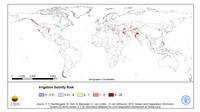Management and Natural Processes affecting the biological and chemical aspects of soils
In addition to physical soil health, chemical and biological soil health can be damaged and degraded. Three major aspects of chemical soil degradation are soil nutrient mining, salinization and pollution.
Soil Nutrient Mining
Nutrient depletion of soils is a widespread soil degradation phenomenon that occurs as a consequence of soil erosion (it is the topsoil in which generally most soil nutrients are present that erodes fastest) but also because of poor management practices, such as slash and burn and other subsistence agricultural practices that do not replenish the nutrients taken out the soil by the crops. Note that nutrient mining is only considered in agricultural areas. No nutrient depletion is expected under other land uses (forestry, pastures). Specific studies concerning nutrient balances are of particular use at local and regional scale. See also, the FAO fertilizer and plant nutrition bulletin #14, Assessment of soil nutrient balance - Approaches and Methodologies.
Soil Pollution
Another aspect of importance to the soil chemical health is the absence of toxic substances in the soil. These are associated with very high input and management levels for instance cadmium toxicity related to high phosphorus applications, while the use of excessive N- fertilizer often leads to pollution of the groundwater.


